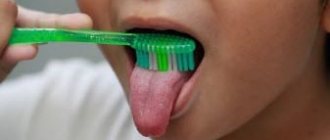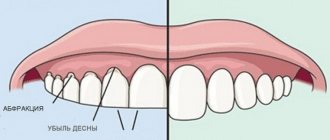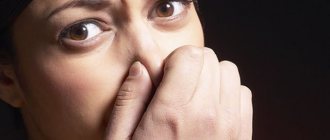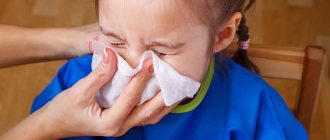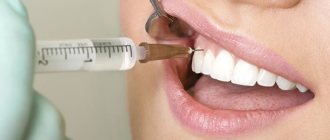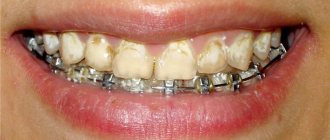29.07.2016
The gag reflex that occurs in response to dental procedures is a rare phenomenon, but very unpleasant for both the dentist and the patient. This annoying response significantly complicates the treatment process and forces the patient to postpone the moment of seeing a doctor until the last minute. And when the patient does come to the clinic, certain technological difficulties arise: difficulties in x-raying teeth, taking impressions, using a saliva ejector, treating lateral teeth or wearing removable dentures.
However, in the twenty-first century, the gag reflex can and should be fought. We will talk further about the causes of the gag reflex and how to cope with it.
Causes of the gag reflex
The gag reflex is provoked by two main groups of reasons: psychological and physiological. Usually a combination of these types of reactions is present. The catalyst for the gag reflex can be pregnancy, gastrointestinal diseases, complicated nasal breathing and stress. The memory of previous problematic dental treatment experiences strengthens the reflex so much that it can be triggered by just the sight of dental equipment or the smell of medications.
Reduce stress and nervousness
Doctors strongly advise patients with an increased gag reflex to prepare for the appointment, take a soothing infusion or herbal decoction, a sedative tablet (Afobazol, Novopassit) at night and in the morning of the day of administration. It is necessary to distract yourself from negative thoughts, not to imagine how unsuccessful and unpleasant a visit to the dentist will be, and even more so to shame yourself in advance. It is good if the patient first seeks advice from a doctor, talks with him, and tells him about his problem during dental treatment. The sincerity and friendliness of a doctor can greatly reduce a person’s stress and fear of necessary procedures.
Elimination of the gag reflex depending on the degree of its severity
The fight against the gag reflex in each case is carried out according to an individual scenario, depending on its severity and a number of other parameters.
Thus, in mild cases, it is effective to use distracting techniques, for example, listening to music or watching videos during dental procedures. A rubber dam is also widely used, isolating the oral cavity from the diseased tooth with a rubber plate, to avoid accidental contact with dental instruments to the palate or gum. Additionally, local anesthesia and antiemetic drugs can be used as a preventive measure. If the gag reflex is more severe, it is necessary to use sedative medications in combination with dental treatment under anesthesia.
Medicines
There are a number of means to help the patient cope with an increased gag reflex during medical procedures. Many of them are used in other areas of medicine. Cerucal is a remedy for taking 3-4 times, 1 tablet a day on the eve of a visit to the doctor and immediately before the appointment. FALIMINT Falimint - also suppresses the vomiting reaction caused by irritation of the tongue and pharynx. Falimint is kept in the mouth until completely absorbed, without chewing, 1-2 tablets per dose 3-5 times a day. Many patients manage to do without medication already at the 2nd or 3rd visit to the doctor, which once again proves the psychological factor in the occurrence of the gag reflex. Lollipops with a strong mint flavor have a distracting effect, but their effect lasts a short time. You can try rinsing your mouth with a strong mint or eucalyptus flavor during the treatment itself.
But do not forget that all medications must be selected in accordance with the patient’s age and contraindications. For young patients, a pediatrician's approval is required in taking antiemetics.
Dental treatment is necessary and there is no need to be ashamed of the gag reflex. Explain the problem to the doctor in advance, discuss possible preparation plans for treatment and the technique itself. It may take a little more time and effort for the entire procedure on the part of both the doctor and the patient. A positive attitude and confidence in success are one of the main factors in achieving positive results!
Universal tips for patients with a gag reflex
- Avoid eating food two to three hours before visiting the dental clinic;
- It is preferable to choose the afternoon to visit the dental clinic, when the severity of the reflex is reduced.
- Full, unobstructed nasal breathing will significantly reduce the likelihood of a reflex occurring. At the slightest approach of the reflex, you need to focus on rhythmic breathing through the nose and exhaling through the mouth. Consult your doctor about the advisability of taking vasoconstrictors or solutions for rinsing the nasal passages.
- Try to train the reflex: daily practicing the presence of objects (a toothbrush, a teaspoon) in your mouth more and more deeply. In many cases, the reflex can be tamed in just a couple of weeks.
- During dental procedures, try to switch problem areas, for example, by sharply clenching your fingers into a fist or raising your leg.
- Sometimes rinsing your mouth with salted water or simply sprinkling a few grains of salt on the tip of your tongue before a dental procedure can be effective.
- Find contact with your doctor. Ask him all the questions that worry and worry you. Tell him about your previous treatment experience, when the reflex appeared, and what causes it. In the Moscow dental clinics “Tavi” and “Veronica”, where an individual approach to each patient is practiced, you will definitely find your doctor, whose treatment will not only be effective, but also comfortable, even in such a rather unusual situation.
Be healthy!
Posted in Useful information
Remedy No. 2: application anesthesia of the palate and tongue
How to reduce the gag reflex at a dentist appointment? Be sure to tell your doctor about your problem before performing any treatment. Experts admit that sometimes a way out of the situation can be found by applying local aerosol anesthesia of lidocaine to the mucous membrane of the palate and tongue. Due to this trick, the sensitivity of all major receptors is blocked, and the patient will be able to more comfortably endure any manipulation, from dental treatment to taking impressions.
The use of lidocaine aerosol may dull the sensitivity of the receptors
If treatment of the teeth of the lower jaw is required, then conduction anesthesia is best suited for patients with a similar problem, which allows you to relieve the sensitivity of not only the diseased tooth, the mucous membrane of the cheek and gums, but also the part of the tongue on which all the main receptors are located.
True, this method does not solve the problem for all patients; some even after using it feel a sore throat and a feeling of slight suffocation.
Appointment and preparation for surgery
After all the above steps are completed, the date for the operation in a dream is set.
It is important to remember that on the day of the appointment there are a number of actions that need to be completed:
- Do not eat or drink anything at all (6-7 hours before the appointed time);
- It is advisable not to smoke (if the habit is strong, 2-3 cigarettes, but no more);
- Do not drink alcohol for 48 hours;
- Take medications (if they were recommended by the anesthesiologist);
- The uniform should be loose, in no way constrictive and easy to unfasten (no elastic bands, complex locks, etc.);
- Appoint an accompanying person who will take you home by car at the end of the operation.
Remedy No. 6: use of anesthesia
If the gag reflex during dental treatment cannot be stopped by any of the methods proposed above, then what else can be done, how to choose general anesthesia as anesthesia. The procedure, unlike sedation, has many contraindications, it requires careful preparation and testing, but it helps solve complex clinical cases such as yours if you cannot overcome the gag reflex.
The use of general anesthesia has a number of contraindications
Can everyone use sedation: consider contraindications
Even the safest medical techniques have contraindications and limitations for use. Sedation is no exception; it cannot be used:
- For hypertension, hypotension;
- With diagnosed neurological and mental diseases;
- In severe pathological processes affecting the respiratory system.
Do not resort to sedation for any acute infectious diseases.
To exclude possible contraindications to the technique, before using sedation, a comprehensive examination is carried out, tests are prescribed, the patient himself must be frank with his doctor and honestly and in detail tell about all the diseases in the anamnesis, the presence of allergic reactions, and his condition at the current moment in time.
Remedy No. 3: use of sedation
How to reduce the gag reflex if you not only have a fairly strong sensitivity of the receptors and mucous membranes, but also have a fear of visiting a doctor? Talk to your dentist about the possibility of using sedation. This method in tandem with local anesthetics will help you completely relax, calm down, and not experience any pain or discomfort. Moreover, during the treatment you will be conscious and will be able to interact with the doctor.
The method is quite safe and does not require special training.
Read on topic: 5 tips on how to stop being afraid of dentists.
What is the difference with anesthesia
Sedation is a relatively new technology, which most people have a vague idea about, and therefore quite often confuse it with general anesthesia. However, the difference between the techniques is fundamental. It consists of the following main points:
- Sedation does not lead to blocking the body’s main reflexes (cough, gag), which are “switched off” when using general anesthesia, and therefore dangerous disorders of the respiratory function during manipulations are completely excluded;
- The person remains conscious, and therefore the connection between him and the doctor remains. When general anesthesia is used, consciousness is switched off under the influence of drugs;
- Sedation has fewer contraindications and does not require lengthy preparation and rehabilitation.
Teeth are treated under sedation with constant monitoring of the patient’s condition, for which special equipment is used. After completing all the necessary procedures, the person is under the supervision of specialists for some time, but can return home on the same day. After using anesthesia, you will have to stay in the clinic for at least 1-2 days.
While talking about the difference between sedation and general anesthesia, it is also important to note the fact that dental treatment during sleep does not involve the risk of unpleasant and dangerous side effects that are common after using general anesthesia.
Comments
I recently had an appointment with an orthopedist; it was necessary to install dentures on the upper jaw, because... there are no teeth at all. At first I wanted to make removable ones, but as soon as the doctor began to manipulate the mouth and take impressions, I had a strong gag reflex. Now I don’t know whether to give up everything or go to the end. I’m very afraid that I won’t be able to get used to it. What do you advise?
Oksana Yuryevna (07.07.2019 at 10:06) Reply to comment
- Dear Oksana Yurievna! First of all, you need to determine the cause of the gag reflex. If you have not experienced problems of this nature before, then it is quite possible that now they are caused precisely by the psychological mood of having to wear removable devices. If the pathology was present before, then removable dentures for the upper jaw are not the best solution in this case, because completely removable devices are quite massive; they will cover the palate, where a large number of receptors are located. It is quite difficult to get used to such prostheses, and in people with sensitive mucous membranes they can actually cause a gag reflex. Perhaps in your case it is better to consider removable dentures on implants or implantation with fixed solutions. Moreover, today there are methods that allow you to restore teeth in less than a week.
Editorial staff of the portal UltraSmile.ru (07/11/2019 at 08:47) Reply to comment
Write your comment Cancel reply
Dental treatment under general anesthesia
General anesthesia in dentistry
When performing an operation, a team consisting of an anesthesiologist-resuscitator, a dentist, a nurse anesthetist, and a dental assistant must be present in the operating room.
First, the patient is fitted with cardiac monitor sensors, a cuff is put on his arm (to continuously measure pressure), and a special sensor is put on his finger to determine saturation (oxygen saturation in the blood), and only after that the anesthetist punctures the vein and a gradual introduction into shallow or deep sleep occurs.
General anesthesia , as well as dental treatment, are carried out under the strict supervision of an anesthesiologist throughout the operation.

